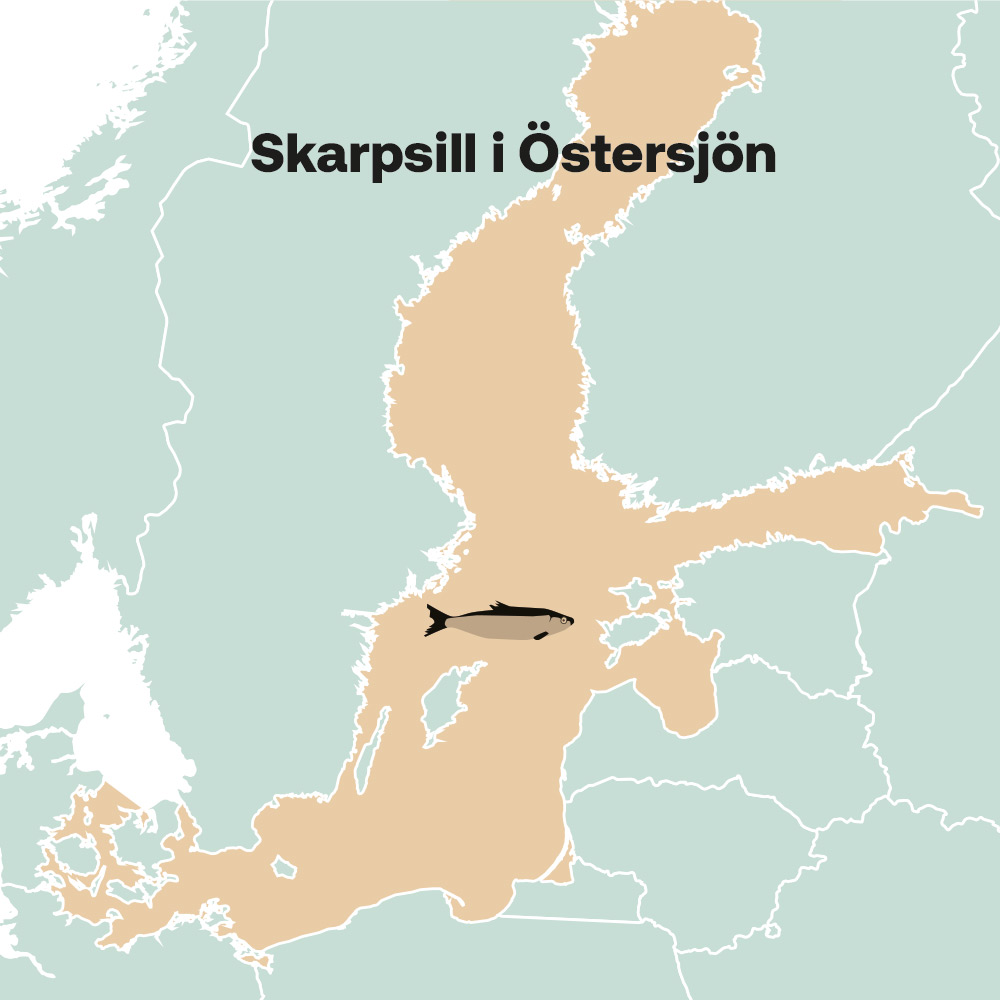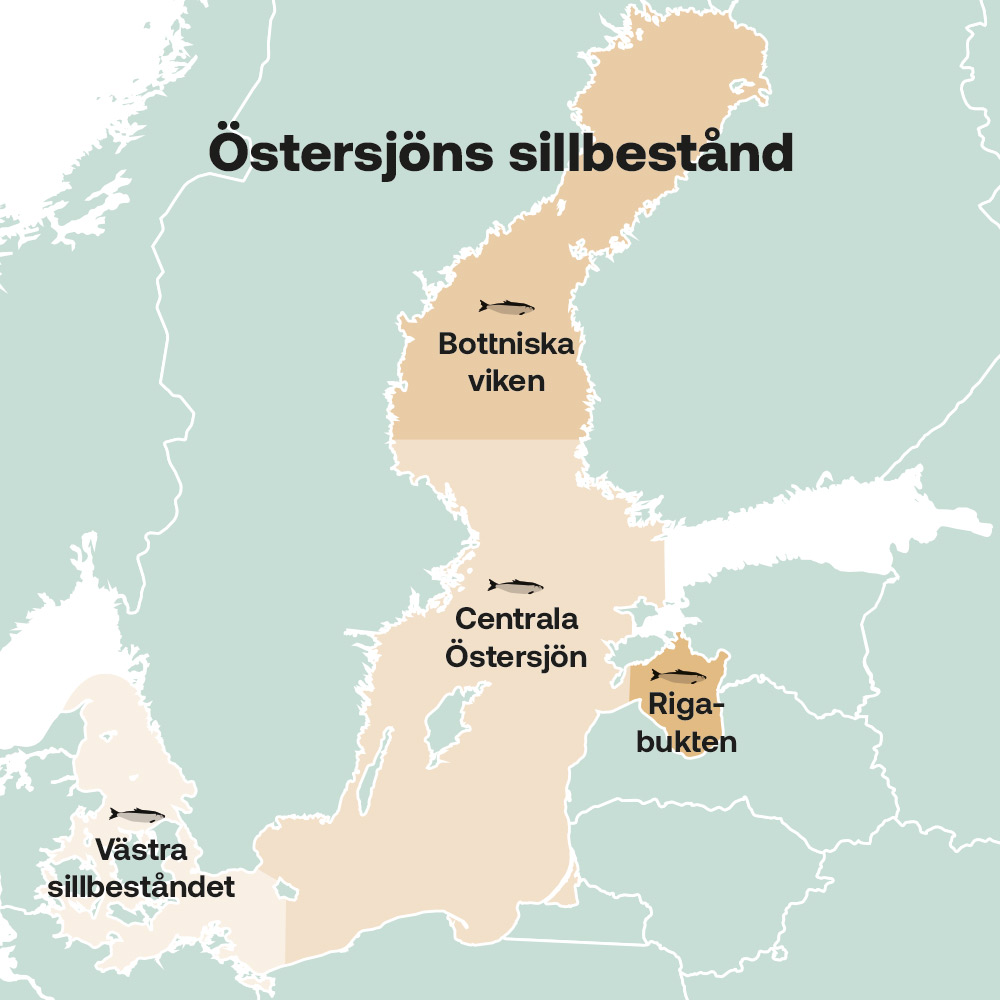Without reducing sprat fishing, herring cannot be protected
The sharp decline of herring in the Baltic Sea is not new. For years there have been alarmist reports about the deteriorating state of the stocks and the need for increased protection and reduced fishing pressure. If herring are to be given a chance to recover, we must also consider sprat – an unknown but important player in the Baltic Sea. As long as sprat fishing is high, reduced quotas for herring will not help.
The sprat is like a little sister to the herring and similarly fulfils an important role as a food base for predatory fish in the ecosystem. The species are similar in appearance and behaviour and are fished in the same way in the large trawl fisheries. They also end up in the same place – the feed industry where they are turned into fishmeal and oil. In other countries, sprat is sold as food, but then called anchovies, sprat or brētliņas. However, like herring, sprat has become increasingly difficult to find in supermarkets, despite the huge amounts fished each year. The anchovies used in, for example, “Jansson’s Temptation” in Sweden come mainly from Norway and England.
What is actually being fished?
Herring and sprat are fished simultaneously in a so-called mixed fishery. As tonnes of fish are pumped from the trawl into the vessel’s tanks, it is difficult for the captain to estimate how much of each species has been caught. Nevertheless, the captain’s estimates are used in scientific advice and form the basis for assessing the size of herring and sprat stocks.
The difficulties in estimating catches are well documented, and there are incentives for captains to report the quota allocated to the vessel, rather than what is actually in the cargo. Misreporting of both weight and species is common, and is also to some extent accepted by management. Only misreporting of more than 10% leads to fines, but in the large cargoes, tens of tonnes can be an “accepted” misreporting. We have previously written about the major deficiencies in control, which hardly increases the captains’ motivation to report accurately and correctly.
The misreporting affects the scientific stock assessments and, since scientists do not take into account possible reporting errors, it results in large uncertainties in the stock estimates. The models rely on the accuracy of the figures reported by captains, which makes the already uncertain stock assessments even less reliable.
Easy to exploit the system
Although herring and sprat are fished together, Baltic herring is divided into four management areas while sprat has only one management area. This means that scientists assess the condition of the herring and give different catch recommendations in four different areas, while the high sprat quota can be fished anywhere in the Baltic Sea – even where the status of the herring is poor. For herring, the blunt management is particularly problematic as we know today that there are many herring populations in the Baltic Sea, such as autumn and spring spawning, and some that spawn in cold waters while others spawn in shallow warm waters. There is strong concern among scientists that many of these populations have been or are being fished out, which would further weaken the delicate ecosystem of the Baltic Sea.


Over 284,000 tonnes of sprat and 254,000 tonnes of herring were caught in the Baltic Sea in 2021. Figure 1: Sprat (area 22-32). Figure 2: The four Baltic Sea herring stocks (20-24, 25-29, 30-31 and 28-1).
The situation can easily be exploited by industrial fisheries, which like to ask for higher quotas for sprat when the quotas for herring go down. In this way, they maintain their high catch quotas without formally requiring fishing on the threatened stocks, even though these can obviously be affected by mixed fishing when they are caught as “by-catch”. A catch that self-monitoring in industrial fishing hardly enters in the logbooks.
Big differences in quota proposals
In the European Commission’s proposal for next year’s fishery, some account has been taken of misreporting and the important role of sprat in the ecosystem, and the quota is therefore at the lower end of the scientific advice, at 201,500 tonnes. The European Commission’s recommendation is the basis for the countries’ negotiations, but other stakeholders also have their say. The large-scale industrial fishery has requested a sprat quota of 317,000 tonnes, which is over 30% of the total stock, while BalticWaters recommended a maximum quota of 124,000 tonnes (50% of FMSY).
Among other things, the industry claims that higher fishing pressure on sprat can provide “space for herring to grow”, which is not supported by research and would hardly work even if it were true, given the uncontrolled mixed fishing. What we see in the Baltic Sea today is just the opposite. Cod is not recovering, growing slowly and having difficulty reaching fishable size. The same applies to herring in the central and northern Baltic Sea.
How is the sprat doing?
The size of the sprat stock is within biologically acceptable levels, although due to the large management area it is not clear whether the situation is different in different areas of the Baltic Sea. The advice only assesses the total weight of the stock and does not take into account the condition of individuals or differences in different areas. Fishing pressure on sprat is currently too high, and appears to be leading to smaller and slower growing individuals, as with herring.

Development in weight of sprat. Source: Baltic Fisheries assessment working group (WGBFAS), ICES.
Since management only considers the total weight of the stock, countries can easily get away with setting high sprat quotas – despite the fact that mixed fishing and systematic misreporting are known in the EU and awareness of the potential impact of sprat fishing on herring stocks is high.
During the ongoing negotiations for next year’s quotas, the sprat quota is expected to be set well above the Commission’s proposal. Sweden can act in the negotiations now, and make important efforts to protect herring and sprat. It is now up to Sweden and the other Member States to prove themselves – will they priorities the Baltic Sea environment, ecosystems and coastal fishing or short-term industrial fishing for feed? So far, everything unfortunately points to the latter.


